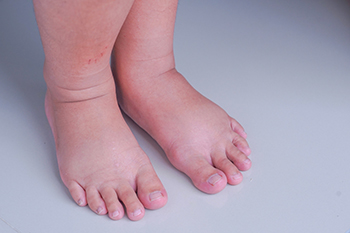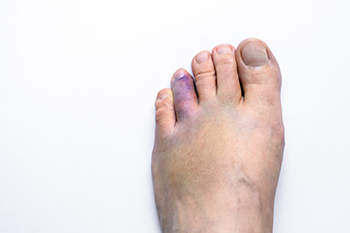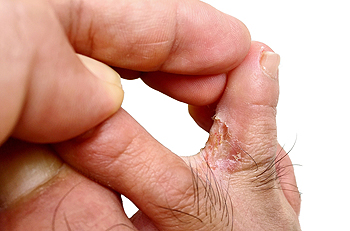Items filtered by date: November 2023
Foods That May Lead To Swollen Feet

Swollen feet can be uncomfortable and concerning, and often, it is not just about wearing the wrong shoes or standing for extended periods. Your diet also plays a significant role in this. Some foods can contribute to fluid retention, leading to swollen feet. Sodium-rich foods, such as processed snacks and canned soups, are notorious culprits. They cause your body to retain water, leading to edema. Sugary foods and beverages can also contribute to this problem, as excessive sugar intake can lead to inflammation and water retention. Additionally, it is essential to watch your alcohol consumption. Alcohol can dehydrate your body, prompting it to retain water when you finally do drink fluids. Furthermore, fried and fatty foods can cause inflammation, impacting circulation and potentially leading to swollen feet. If you have noticed your feet have become swollen, it is suggested that you are under the care of a podiatrist who can guide you toward relief and prevention tactics.
Swollen feet can be a sign of an underlying condition. If you have any concerns, contact one of our podiatrists of Ankle & Foot of Edmonds. Our doctors can provide the care you need to keep you pain-free and on your feet.
Swollen feet are a common ailment among pregnant women and people who stand or sit for extended periods. Aging may increase the possibility of swollen feet and patients who are obese often notice when their feet are swelling too. There may be medical reasons why swollen feet occur:
- Phlebitis - A condition that causes the veins to become inflamed and can also cause leg pain.
- Liver disease - This may lead to low blood levels of albumin which is a protein. This can cause fluid in the blood to pass into the tissues and several areas of the body can become swollen.
- Heart failure - When the heart doesn’t pump properly the blood that is normally pumped back to the heart can pool in the veins of the legs causing swollen feet.
- Kidney disease - One of the main functions of the kidneys is releasing excess fluid in the body. This type of condition can make it difficult for the kidneys to function properly, and as a result the feet may become swollen.
- Deep-vein thrombosis (DVT)- This is a serious condition where blood clots form in the veins of the legs. They can block the return of blood from the legs to the heart which may cause the feet to swell. It is important to be treated by a podiatrist if this condition is present.
Swollen feet can also be caused by bone and tendon conditions, including fractures, arthritis, and tendinitis. Additionally, there may be skin and toenail conditions and an infection may cause the feet to swell. Patients who take medicine to treat high blood pressure may be prone to getting swollen feet.
Many patients elevate their feet to help relieve the swelling and this is generally a temporary remedy. When a podiatrist is consulted the reason behind the swelling can be uncovered and subsequently treated.
If you have any questions please feel free to contact our office located in Edmonds, WA . We offer the newest diagnostic tools and technology to treat your foot and ankle needs.
Broken Toe Symptoms Are Difficult to Dismiss

A broken toe, or toe fracture, is a painful injury when one or more toe bones, known as phalanges, sustain damage. This injury typically results from a sudden impact or trauma, such as stubbing the toe, dropping a heavy object on it, or experiencing a direct blow during sports or accidents. The symptoms of a broken toe are distinct and hard to miss. The most common sign is immediate pain and discomfort, which can range from mild to severe, depending on the extent of the fracture. Additionally, swelling, bruising, and tenderness around the affected area are typical and may worsen over time. The toe may also appear misshapen or out of alignment, making it challenging to move or bear weight. In some cases, you may even hear a cracking or popping sound at the time of the injury. Proper diagnosis and timely treatment are essential for a full and safe recovery. If you have sustained a broken toe, it is strongly suggested that you consult a podiatrist who can accurately diagnose and treat this condition.
Broken toes may cause a lot of pain and should be treated as soon as possible. If you have any concerns about your feet, contact one of our podiatrists from Ankle & Foot of Edmonds. Our doctors will treat your foot and ankle needs.
What Is a Broken Toe?
A broken toe occurs when one or more of the toe bones of the foot are broken after an injury. Injuries such as stubbing your toe or dropping a heavy object on it may cause a toe fracture.
Symptoms of a Broken Toe
- Swelling
- Pain (with/without wearing shoes)
- Stiffness
- Nail Injury
Although the injured toe should be monitored daily, it is especially important to have a podiatrist look at your toe if you have severe symptoms. Some of these symptoms include worsening or new pain that is not relieved with medication, sores, redness, or open wounds near the toe.
If you have any questions, please feel free to contact our office located in Edmonds, WA . We offer the newest diagnostic and treatment technologies for all your foot care needs.
Assessing Diabetic Foot Ulcers

Diabetic foot ulcers are difficult wounds to heal because they can be caused by many factors. Podiatrists have different ways to treat these ulcers, including looking at blood flow problems. Neuroischemic ulcers develop from poor blood flow and nerve damage in the feet, making up approximately half of the cases of diabetic foot ulcers. When a patient has a diabetic foot ulcer, a podiatrist looks at their entire health history, asks about their daily habits, and checks how well they can move and complete everyday activities. The foot doctor also needs to know what medications the patient is taking, as some can slow down healing. All this information helps them determine the best way to treat the ulcer. The top goals are to find out what is causing the ulcer, determine how to stop it from getting worse and encourage the patient to follow the treatment plan. If you have diabetes and have developed a foot ulcer, it is strongly suggested that you make an appointment with a podiatrist as quickly as possible for a thorough assessment, examination, and treatment plan.
Wound care is an important part in dealing with diabetes. If you have diabetes and a foot wound or would like more information about wound care for diabetics, consult with one of our podiatrists from Ankle & Foot of Edmonds. Our doctors will assess your condition and provide you with quality foot and ankle treatment.
What Is Wound Care?
Wound care is the practice of taking proper care of a wound. This can range from the smallest to the largest of wounds. While everyone can benefit from proper wound care, it is much more important for diabetics. Diabetics often suffer from poor blood circulation which causes wounds to heal much slower than they would in a non-diabetic.
What Is the Importance of Wound Care?
While it may not seem apparent with small ulcers on the foot, for diabetics, any size ulcer can become infected. Diabetics often also suffer from neuropathy, or nerve loss. This means they might not even feel when they have an ulcer on their foot. If the wound becomes severely infected, amputation may be necessary. Therefore, it is of the upmost importance to properly care for any and all foot wounds.
How to Care for Wounds
The best way to care for foot wounds is to prevent them. For diabetics, this means daily inspections of the feet for any signs of abnormalities or ulcers. It is also recommended to see a podiatrist several times a year for a foot inspection. If you do have an ulcer, run the wound under water to clear dirt from the wound; then apply antibiotic ointment to the wound and cover with a bandage. Bandages should be changed daily and keeping pressure off the wound is smart. It is advised to see a podiatrist, who can keep an eye on it.
If you have any questions, please feel free to contact our office located in Edmonds, WA . We offer the newest diagnostic and treatment technologies for all your foot care needs.
Do You Suffer From Painful Feet?
Athlete's Foot Is a Common Fungal Infection

Athlete's foot, medically known as tinea pedis, is a prevalent fungal infection that affects the skin on the feet, often between the toes. This condition can strike anyone, not just athletes, and is primarily caused by dermatophyte fungi. Athlete's foot thrives in warm, moist environments, making it a common occurrence in areas like locker rooms, swimming pools, and shared showers. The symptoms of athlete's foot typically include itching, burning, and stinging sensations on the affected skin. As the infection progresses, it may lead to peeling, redness, and the development of blisters or cracked skin. In severe cases, the condition can spread to other parts of the foot, including the toenails. Fortunately, athlete's foot is usually easily treatable by visiting a podiatrist who can offer you prescribed medication for relief. If you have developed athlete’s foot, it is suggested that you schedule an appointment with this type of doctor who can guide you toward effective prevention methods.
Athlete’s foot is an inconvenient condition that can be easily reduced with the proper treatment. If you have any concerns about your feet and ankles, contact one of our podiatrists from Ankle & Foot of Edmonds. Our doctors will treat your foot and ankle needs.
Athlete’s Foot: The Sole Story
Athlete's foot, also known as tinea pedis, can be an extremely contagious foot infection. It is commonly contracted in public changing areas and bathrooms, dormitory style living quarters, around locker rooms and public swimming pools, or anywhere your feet often come into contact with other people.
Solutions to Combat Athlete’s Foot
- Hydrate your feet by using lotion
- Exfoliate
- Buff off nails
- Use of anti-fungal products
- Examine your feet and visit your doctor if any suspicious blisters or cuts develop
Athlete’s foot can cause many irritating symptoms such as dry and flaking skin, itching, and redness. Some more severe symptoms can include bleeding and cracked skin, intense itching and burning, and even pain when walking. In the worst cases, Athlete’s foot can cause blistering as well. Speak to your podiatrist for a better understanding of the different causes of Athlete’s foot, as well as help in determining which treatment options are best for you.
If you have any questions please feel free to contact our office located in Edmonds, WA . We offer the newest diagnostic and treatment technologies for all your foot and ankle needs.

